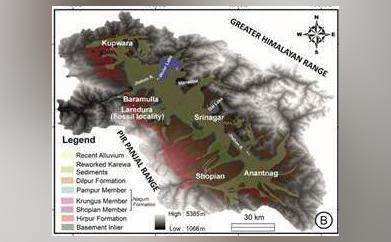
Kashmir Valley was a warm, humid subtropical paradise millions of years ago: Study
The breathtaking beauty of the Kashmir Valley, with its snow-capped mountains, lush green meadows, and serene lakes, is a testament to the region’s unique geography and climate. While the valley’s cool Mediterranean-type climate is a major draw for tourists and locals alike, a recent study by Indian scientists has revealed that the region was once a warm and humid “subtropical paradise” millions of years ago. This astonishing discovery has shed new light on the region’s climatic history and the dramatic changes that have shaped its landscape over time.
According to a study published by the Indian scientists, the Kashmir Valley was a warm and humid subtropical region with a climate similar to that of present-day Malaysia or Indonesia. The researchers used a technique called Climate Leaf Analysis Multivariate Program (CLAMP) to analyze fossil leaves found in the valley, which dated back millions of years. The CLAMP method uses a combination of physical and chemical characteristics of fossil leaves to reconstruct ancient climates.
The study, which was conducted by a team of researchers from the Indian Institute of Technology (IIT) Delhi and the University of Kashmir, found that the climate in the Kashmir Valley was much warmer during the Eocene epoch, which was around 50-40 million years ago. During this period, the region experienced temperatures that were comparable to those found in present-day tropical regions, with average temperatures ranging from 15°C to 25°C (59°F to 77°F).
The researchers linked the changes in climate to the tectonic uplift of the Pir Panjal Range, a sub-Himalayan mountain range that runs through the Kashmir Valley. The uplift of the Pir Panjal Range is believed to have occurred around 50-40 million years ago, and it is thought to have played a key role in changing the region’s climate.
The uplift of the mountain range led to the formation of a rain shadow effect, which created a barrier that blocked the flow of moist air from the Indian Ocean and the Arabian Sea. As a result, the climate in the Kashmir Valley became drier and cooler, leading to the formation of a Mediterranean-type climate that is characteristic of the region today.
The study’s findings have significant implications for our understanding of the region’s climatic history and the impact of tectonic activity on the environment. The researchers believe that the study’s results could also have important implications for the region’s ecosystem and biodiversity, particularly in terms of the evolution of plant species that are adapted to the valley’s unique climate conditions.
The study’s lead author, Dr. Anurag Sharma, a scientist at IIT Delhi, said that the research had provided new insights into the region’s climatic history and the impact of tectonic activity on the environment. “Our study has shown that the Kashmir Valley was once a warm and humid subtropical region, and that the tectonic uplift of the Pir Panjal Range played a key role in changing the region’s climate,” Dr. Sharma said.
The study’s findings are also significant in terms of their implications for the region’s natural resources and ecosystem. The researchers believe that the study’s results could help to inform conservation efforts and the management of natural resources in the region.
In conclusion, the study by Indian scientists has revealed that the Kashmir Valley was once a warm and humid subtropical paradise, with a climate similar to that of present-day tropical regions. The researchers linked the changes in climate to the tectonic uplift of the Pir Panjal Range, which is believed to have occurred around 50-40 million years ago. The study’s findings have significant implications for our understanding of the region’s climatic history and the impact of tectonic activity on the environment, and could also have important implications for the region’s ecosystem and biodiversity.






